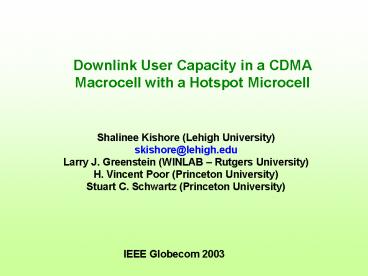Downlink User Capacity in a CDMA - PowerPoint PPT Presentation
1 / 16
Title:
Downlink User Capacity in a CDMA
Description:
... gain W/R and minimum SIR requirement ... Tjk = r Tjk. Overview of Analysis (Cont'd) Using SINR requirement for ... depends on b (RHS) and DF (LHS). We ... – PowerPoint PPT presentation
Number of Views:64
Avg rating:3.0/5.0
Title: Downlink User Capacity in a CDMA
1
Downlink User Capacity in a CDMA Macrocell with a
Hotspot Microcell
Shalinee Kishore (Lehigh University) skishore_at_lehi
gh.edu Larry J. Greenstein (WINLAB Rutgers
University) H. Vincent Poor (Princeton
University) Stuart C. Schwartz (Princeton
University)
IEEE Globecom 2003
2
Two-Tier Cellular CDMA System
Macrocell with embedded Microcell
- Both macrocell and microcell use CDMA over same
- set of frequencies ? cross-tier interference.
- Goal Derive analytical methods that compute
downlink - user capacity and account for
- Finitely dispersive channels
- Various methods of downlink power control
3
Downlink Capacity Background
- CDMA downlink Base stations transmit
orthogonal - signals to users.
- Channel dispersion causes loss of orthogonality
at user - terminals.
- Orthogonality factor, b, captures
loss-of-orthogonality - of user signals in a channel.
- b ? 0,1, where b 0 when no dispersion in
channel - and b 1 when infinite dispersion.
- b can be computed from channel delay profile.
4
Orthogonality Factor
Assuming all Rayleigh fading paths, it has been
shown that
where rn is instantaneous gain on n-th path s.t.
b is time-varying but earlier simulation results
show little difference in replacing time
variation by its average.
5
- Downlink Capacity Problem Statement
- Given
- Single-macrocell/single-microcell system with N
NMNm - users, processing gain W/R and minimum SIR
requirement G. - Channel delay profile ? orthogonality factor,
b. - Conventional RAKE receivers at user terminals
- Base station k transmits total power PTk, k ?
M,m - Macrocell user i assigned fraction xi of PTM
- Microcell user j assigned fraction yj of PTm
- Downlink power control scheme for allocating xi
and yj
6
Overview of Analysis
Instantaneous interference power to macrocell
user k from macrocell base is
where TMk is instantaneous path gain between user
k and macrocell base. (Similar interference at
microcell user.)
- We denote
- TMk as the fast-varying path gain and
- TMk as the slow-varying (locally-averaged) path
gain.
7
Digression Slow-varying Path Gain Model
Fast-varying Path Gain Model
where,
Tjk r Tjk
rn depends on the channel delay profile.
8
Overview of Analysis (Contd)
Using SINR requirement for macrocell user i and
microcell user j, we show that PTM 0 and PTm
0 iff
Downlink feasibility condition
where K W/RG .
- Feasibility condition must be met some given
percentage of - time by all
- i ? UM (set of macrocell users) and
- j ? Um (set of microcell users)
- Feasibility conditions depend on allocations xi
yj.
9
3 Power Control Schemes
- Uniform power control xi 1/NM and yj
1/Nm. - Slow power control power allocation determined
from - slow-varying path gains.
- Fast power control power allocation
determined from - fast-varying path gains.
- Under fast power control, there exists a single
feasibility - condition
10
Approximating Capacity for Fast Power Control
- We can approximate feasibility under fast power
control - by substituting LHS of feasibility condition by
its average.
- We find this average for the uniform multipath
channel. - Recall uniform multipath delay profile
power
Height of each line is mean- square gain of a
Rayleigh fading path.
delay
Lp Number of Paths
11
Digression Treating Non-Uniform Delay Profiles
- For uniform channels, we can compute LHS of
- feasibility condition as a simple function of
Lp. - What about non-uniform channels?
- In uplink study, we showed approximate
equivalence - between uniform and non-uniform channels using
the - channel diversity factor.
- Diversity factor (DF) can be computed for any
profile. - Substituting DF for Lp, we can approximate
average of - LHS for non-uniform channels.
12
Approximating Capacity for Fast PC (Contd)
- Using mean approximation, feasibility condition
- depends on b (RHS) and DF (LHS).
- We found that for DF gt 1,
- Therefore, feasibility condition can be written
in - terms of b.
- For maximum total user capacity, NM Nm.
- Combining these results, we obtain
Closed-form solution for downlink user capacity
13
Uplink User Capacity as a Function of b
We can recast uplink user capacity in terms of b
14
Comparing Uplink and Downlink User Capacities
- We have uplink user capacity in terms of b.
- We have downlink user capacity for fast PC in
terms of b. - We can also obtain downlink user capacity in
terms of - b for uniform and slow PC.
Major Findings
- Uplink dominates downlink for uniform and slow
PC. - Downlink dominates uplink for fast PC.
15
Comparing Uplink and Downlink User Capacities for
Fast Power Control
Rural Area Hilly Terrain Typical Urban
Downlink User Capacity
Total Number of Users
Uplink User Capacity
b, Orthgonality Factor
16
Conclusion
- Derived downlink feasibility condition for
single-frequency - two-tier CDMA system in finitely-dispersive
channels. - Used uniform multipath channel to approximate
- downlink user capacity under fast power
control. - Found excellent agreements between analytical
- approximations and simulation results.
- Showed that, for uniform and slow power control,
- downlink dominated by uplink.
- Showed that, for fast power control, uplink
dominated - by downlink, underscoring importance of fast
power - control on two-tier CDMA downlinks.































